Zhiping Cai
RAG-Adapter: A Plug-and-Play RAG-enhanced Framework for Long Video Understanding
Mar 11, 2025Abstract:Multi-modal Large Language Models (MLLMs) capable of video understanding are advancing rapidly. To effectively assess their video comprehension capabilities, long video understanding benchmarks, such as Video-MME and MLVU, are proposed. However, these benchmarks directly use uniform frame sampling for testing, which results in significant information loss and affects the accuracy of the evaluations in reflecting the true abilities of MLLMs. To address this, we propose RAG-Adapter, a plug-and-play framework that reduces information loss during testing by sampling frames most relevant to the given question. Additionally, we introduce a Grouped-supervised Contrastive Learning (GCL) method to further enhance sampling effectiveness of RAG-Adapter through fine-tuning on our constructed MMAT dataset. Finally, we test numerous baseline MLLMs on various video understanding benchmarks, finding that RAG-Adapter sampling consistently outperforms uniform sampling (e.g., Accuracy of GPT-4o increases by 9.3 percent on Video-MME), providing a more accurate testing method for long video benchmarks.
ALLVB: All-in-One Long Video Understanding Benchmark
Mar 10, 2025Abstract:From image to video understanding, the capabilities of Multi-modal LLMs (MLLMs) are increasingly powerful. However, most existing video understanding benchmarks are relatively short, which makes them inadequate for effectively evaluating the long-sequence modeling capabilities of MLLMs. This highlights the urgent need for a comprehensive and integrated long video understanding benchmark to assess the ability of MLLMs thoroughly. To this end, we propose ALLVB (ALL-in-One Long Video Understanding Benchmark). ALLVB's main contributions include: 1) It integrates 9 major video understanding tasks. These tasks are converted into video QA formats, allowing a single benchmark to evaluate 9 different video understanding capabilities of MLLMs, highlighting the versatility, comprehensiveness, and challenging nature of ALLVB. 2) A fully automated annotation pipeline using GPT-4o is designed, requiring only human quality control, which facilitates the maintenance and expansion of the benchmark. 3) It contains 1,376 videos across 16 categories, averaging nearly 2 hours each, with a total of 252k QAs. To the best of our knowledge, it is the largest long video understanding benchmark in terms of the number of videos, average duration, and number of QAs. We have tested various mainstream MLLMs on ALLVB, and the results indicate that even the most advanced commercial models have significant room for improvement. This reflects the benchmark's challenging nature and demonstrates the substantial potential for development in long video understanding.
MetaTrading: An Immersion-Aware Model Trading Framework for Vehicular Metaverse Services
Oct 25, 2024
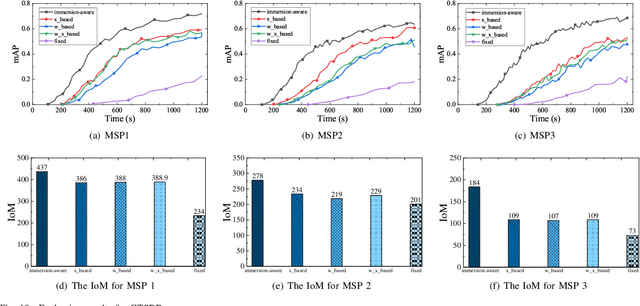
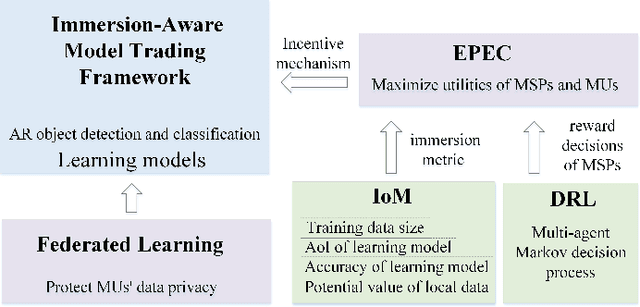
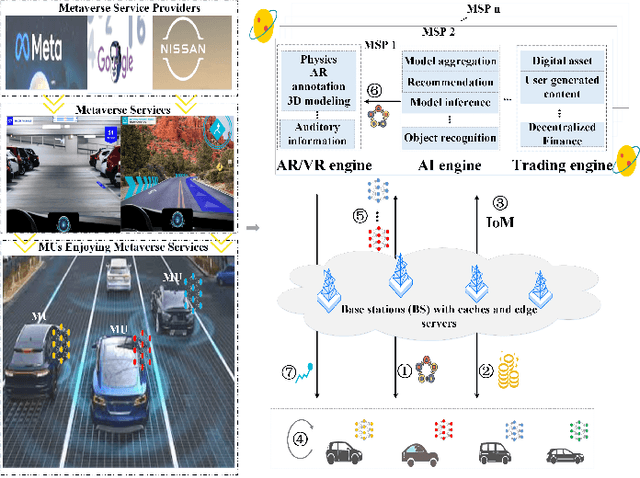
Abstract:Updates of extensive Internet of Things (IoT) data are critical to the immersion of vehicular metaverse services. However, providing high-quality and sustainable data in unstable and resource-constrained vehicular networks remains a significant challenge. To address this problem, we put forth a novel immersion-aware model trading framework that incentivizes metaverse users (MUs) to contribute learning models trained by their latest local data for augmented reality (AR) services in the vehicular metaverse, while preserving their privacy through federated learning. To comprehensively evaluate the contribution of locally trained learning models provided by MUs to AR services, we design a new immersion metric that captures service immersion by considering the freshness and accuracy of learning models, as well as the amount and potential value of raw data used for training. We model the trading interactions between metaverse service providers (MSPs) and MUs as an equilibrium problem with equilibrium constraints (EPEC) to analyze and balance their costs and gains. Moreover, considering dynamic network conditions and privacy concerns, we formulate the reward decisions of MSPs as a multi-agent Markov decision process. Then, a fully distributed dynamic reward method based on deep reinforcement learning is presented, which operates without any private information about MUs and other MSPs. Experimental results demonstrate that the proposed framework can effectively provide higher-value models for object detection and classification in AR services on real AR-related vehicle datasets compared to benchmark schemes.
DiffusionEdge: Diffusion Probabilistic Model for Crisp Edge Detection
Jan 09, 2024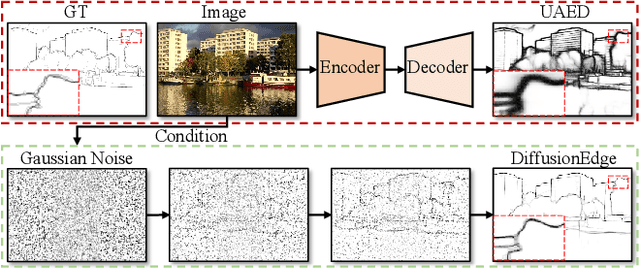

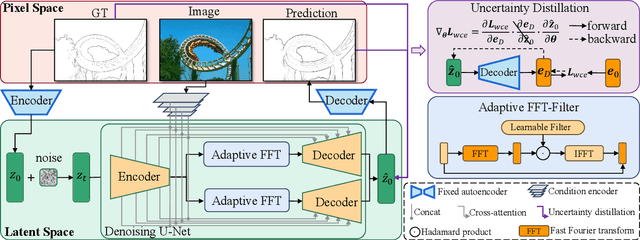
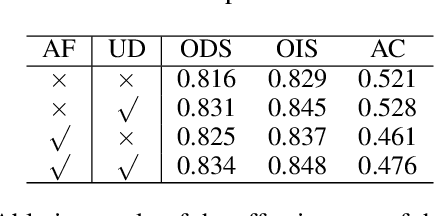
Abstract:Limited by the encoder-decoder architecture, learning-based edge detectors usually have difficulty predicting edge maps that satisfy both correctness and crispness. With the recent success of the diffusion probabilistic model (DPM), we found it is especially suitable for accurate and crisp edge detection since the denoising process is directly applied to the original image size. Therefore, we propose the first diffusion model for the task of general edge detection, which we call DiffusionEdge. To avoid expensive computational resources while retaining the final performance, we apply DPM in the latent space and enable the classic cross-entropy loss which is uncertainty-aware in pixel level to directly optimize the parameters in latent space in a distillation manner. We also adopt a decoupled architecture to speed up the denoising process and propose a corresponding adaptive Fourier filter to adjust the latent features of specific frequencies. With all the technical designs, DiffusionEdge can be stably trained with limited resources, predicting crisp and accurate edge maps with much fewer augmentation strategies. Extensive experiments on four edge detection benchmarks demonstrate the superiority of DiffusionEdge both in correctness and crispness. On the NYUDv2 dataset, compared to the second best, we increase the ODS, OIS (without post-processing) and AC by 30.2%, 28.1% and 65.1%, respectively. Code: https://github.com/GuHuangAI/DiffusionEdge.
RayMVSNet++: Learning Ray-based 1D Implicit Fields for Accurate Multi-View Stereo
Jul 16, 2023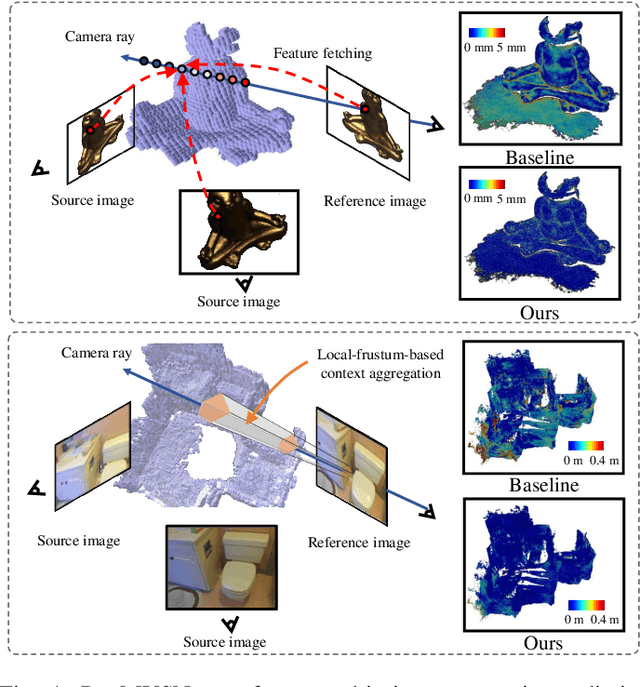
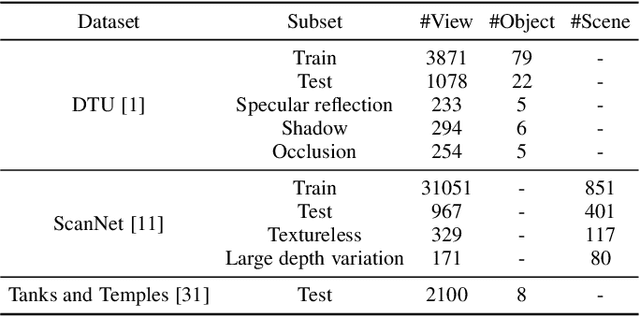
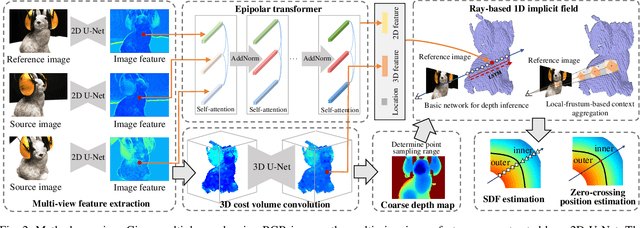
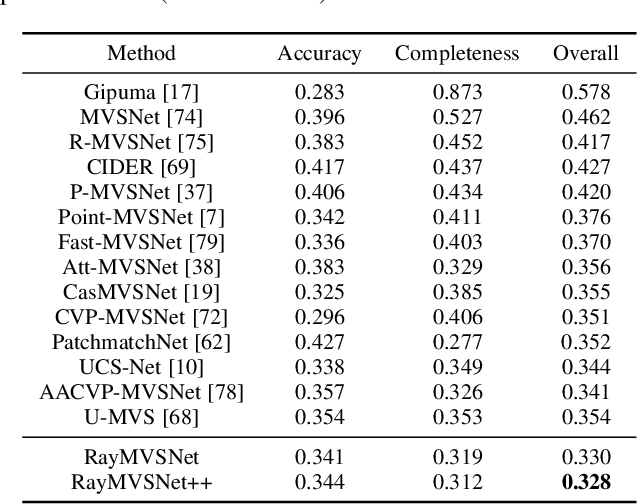
Abstract:Learning-based multi-view stereo (MVS) has by far centered around 3D convolution on cost volumes. Due to the high computation and memory consumption of 3D CNN, the resolution of output depth is often considerably limited. Different from most existing works dedicated to adaptive refinement of cost volumes, we opt to directly optimize the depth value along each camera ray, mimicking the range finding of a laser scanner. This reduces the MVS problem to ray-based depth optimization which is much more light-weight than full cost volume optimization. In particular, we propose RayMVSNet which learns sequential prediction of a 1D implicit field along each camera ray with the zero-crossing point indicating scene depth. This sequential modeling, conducted based on transformer features, essentially learns the epipolar line search in traditional multi-view stereo. We devise a multi-task learning for better optimization convergence and depth accuracy. We found the monotonicity property of the SDFs along each ray greatly benefits the depth estimation. Our method ranks top on both the DTU and the Tanks & Temples datasets over all previous learning-based methods, achieving an overall reconstruction score of 0.33mm on DTU and an F-score of 59.48% on Tanks & Temples. It is able to produce high-quality depth estimation and point cloud reconstruction in challenging scenarios such as objects/scenes with non-textured surface, severe occlusion, and highly varying depth range. Further, we propose RayMVSNet++ to enhance contextual feature aggregation for each ray through designing an attentional gating unit to select semantically relevant neighboring rays within the local frustum around that ray. RayMVSNet++ achieves state-of-the-art performance on the ScanNet dataset. In particular, it attains an AbsRel of 0.058m and produces accurate results on the two subsets of textureless regions and large depth variation.
Delving into Crispness: Guided Label Refinement for Crisp Edge Detection
Jun 27, 2023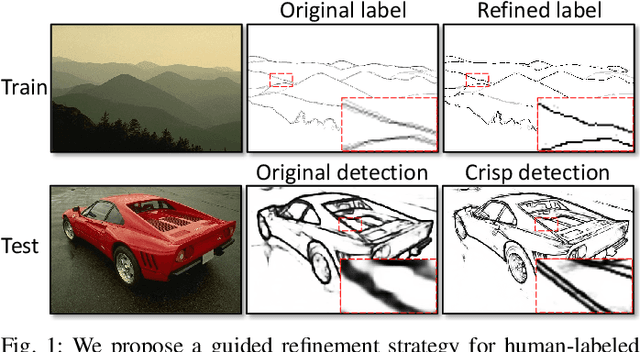
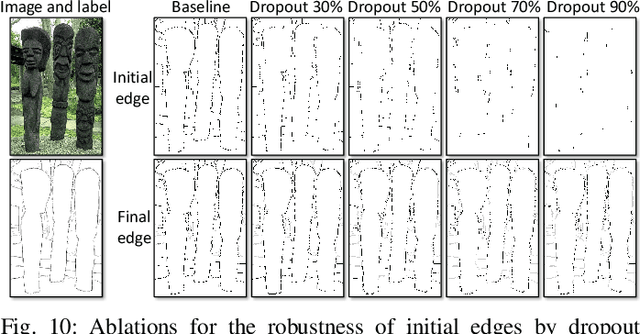
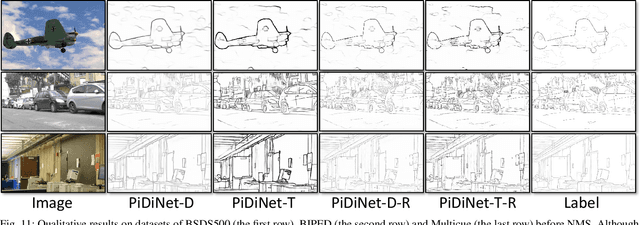
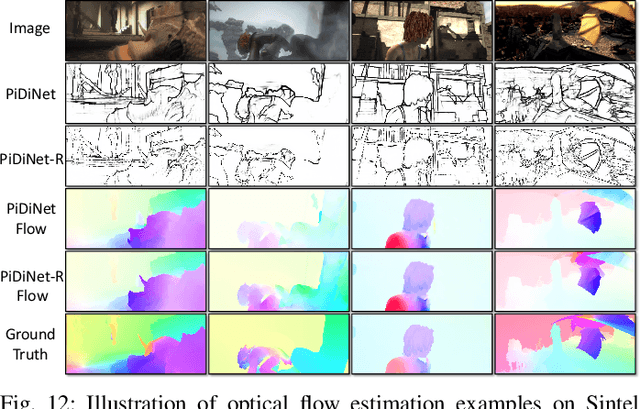
Abstract:Learning-based edge detection usually suffers from predicting thick edges. Through extensive quantitative study with a new edge crispness measure, we find that noisy human-labeled edges are the main cause of thick predictions. Based on this observation, we advocate that more attention should be paid on label quality than on model design to achieve crisp edge detection. To this end, we propose an effective Canny-guided refinement of human-labeled edges whose result can be used to train crisp edge detectors. Essentially, it seeks for a subset of over-detected Canny edges that best align human labels. We show that several existing edge detectors can be turned into a crisp edge detector through training on our refined edge maps. Experiments demonstrate that deep models trained with refined edges achieve significant performance boost of crispness from 17.4% to 30.6%. With the PiDiNet backbone, our method improves ODS and OIS by 12.2% and 12.6% on the Multicue dataset, respectively, without relying on non-maximal suppression. We further conduct experiments and show the superiority of our crisp edge detection for optical flow estimation and image segmentation.
RARE: Robust Masked Graph Autoencoder
Apr 06, 2023Abstract:Masked graph autoencoder (MGAE) has emerged as a promising self-supervised graph pre-training (SGP) paradigm due to its simplicity and effectiveness. However, existing efforts perform the mask-then-reconstruct operation in the raw data space as is done in computer vision (CV) and natural language processing (NLP) areas, while neglecting the important non-Euclidean property of graph data. As a result, the highly unstable local connection structures largely increase the uncertainty in inferring masked data and decrease the reliability of the exploited self-supervision signals, leading to inferior representations for downstream evaluations. To address this issue, we propose a novel SGP method termed Robust mAsked gRaph autoEncoder (RARE) to improve the certainty in inferring masked data and the reliability of the self-supervision mechanism by further masking and reconstructing node samples in the high-order latent feature space. Through both theoretical and empirical analyses, we have discovered that performing a joint mask-then-reconstruct strategy in both latent feature and raw data spaces could yield improved stability and performance. To this end, we elaborately design a masked latent feature completion scheme, which predicts latent features of masked nodes under the guidance of high-order sample correlations that are hard to be observed from the raw data perspective. Specifically, we first adopt a latent feature predictor to predict the masked latent features from the visible ones. Next, we encode the raw data of masked samples with a momentum graph encoder and subsequently employ the resulting representations to improve predicted results through latent feature matching. Extensive experiments on seventeen datasets have demonstrated the effectiveness and robustness of RARE against state-of-the-art (SOTA) competitors across three downstream tasks.
NEF: Neural Edge Fields for 3D Parametric Curve Reconstruction from Multi-view Images
Mar 16, 2023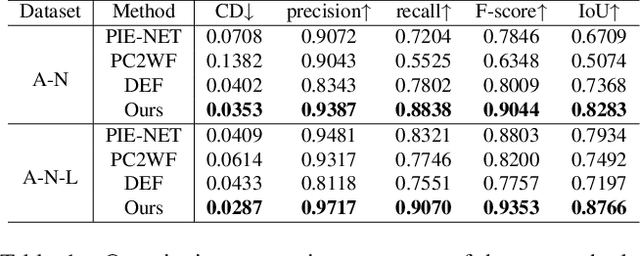
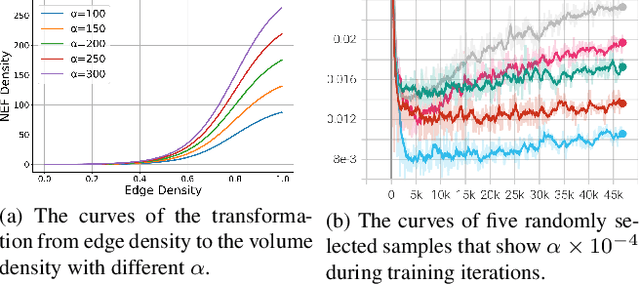


Abstract:We study the problem of reconstructing 3D feature curves of an object from a set of calibrated multi-view images. To do so, we learn a neural implicit field representing the density distribution of 3D edges which we refer to as Neural Edge Field (NEF). Inspired by NeRF, NEF is optimized with a view-based rendering loss where a 2D edge map is rendered at a given view and is compared to the ground-truth edge map extracted from the image of that view. The rendering-based differentiable optimization of NEF fully exploits 2D edge detection, without needing a supervision of 3D edges, a 3D geometric operator or cross-view edge correspondence. Several technical designs are devised to ensure learning a range-limited and view-independent NEF for robust edge extraction. The final parametric 3D curves are extracted from NEF with an iterative optimization method. On our benchmark with synthetic data, we demonstrate that NEF outperforms existing state-of-the-art methods on all metrics. Project page: https://yunfan1202.github.io/NEF/.
Revisiting Initializing Then Refining: An Incomplete and Missing Graph Imputation Network
Feb 15, 2023Abstract:With the development of various applications, such as social networks and knowledge graphs, graph data has been ubiquitous in the real world. Unfortunately, graphs usually suffer from being absent due to privacy-protecting policies or copyright restrictions during data collection. The absence of graph data can be roughly categorized into attribute-incomplete and attribute-missing circumstances. Specifically, attribute-incomplete indicates that a part of the attribute vectors of all nodes are incomplete, while attribute-missing indicates that the whole attribute vectors of partial nodes are missing. Although many efforts have been devoted, none of them is custom-designed for a common situation where both types of graph data absence exist simultaneously. To fill this gap, we develop a novel network termed Revisiting Initializing Then Refining (RITR), where we complete both attribute-incomplete and attribute-missing samples under the guidance of a novel initializing-then-refining imputation criterion. Specifically, to complete attribute-incomplete samples, we first initialize the incomplete attributes using Gaussian noise before network learning, and then introduce a structure-attribute consistency constraint to refine incomplete values by approximating a structure-attribute correlation matrix to a high-order structural matrix. To complete attribute-missing samples, we first adopt structure embeddings of attribute-missing samples as the embedding initialization, and then refine these initial values by adaptively aggregating the reliable information of attribute-incomplete samples according to a dynamic affinity structure. To the best of our knowledge, this newly designed method is the first unsupervised framework dedicated to handling hybrid-absent graphs. Extensive experiments on four datasets have verified that our methods consistently outperform existing state-of-the-art competitors.
STEdge: Self-training Edge Detection with Multi-layer Teaching and Regularization
Jan 13, 2022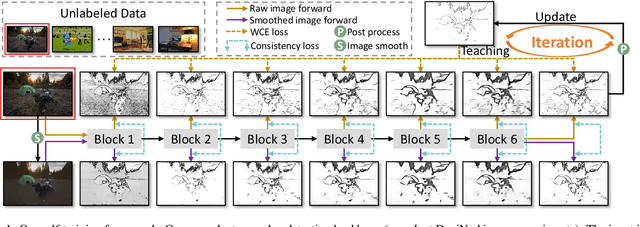

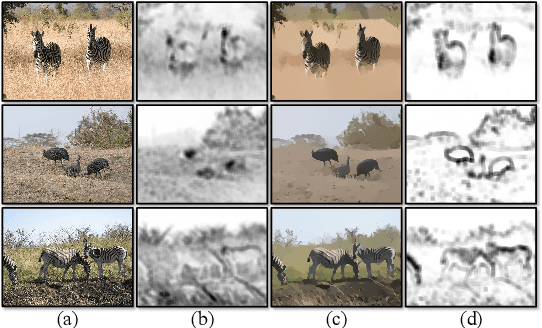
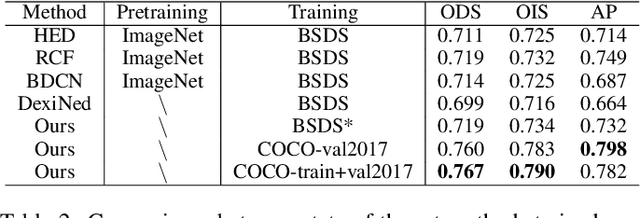
Abstract:Learning-based edge detection has hereunto been strongly supervised with pixel-wise annotations which are tedious to obtain manually. We study the problem of self-training edge detection, leveraging the untapped wealth of large-scale unlabeled image datasets. We design a self-supervised framework with multi-layer regularization and self-teaching. In particular, we impose a consistency regularization which enforces the outputs from each of the multiple layers to be consistent for the input image and its perturbed counterpart. We adopt L0-smoothing as the 'perturbation' to encourage edge prediction lying on salient boundaries following the cluster assumption in self-supervised learning. Meanwhile, the network is trained with multi-layer supervision by pseudo labels which are initialized with Canny edges and then iteratively refined by the network as the training proceeds. The regularization and self-teaching together attain a good balance of precision and recall, leading to a significant performance boost over supervised methods, with lightweight refinement on the target dataset. Furthermore, our method demonstrates strong cross-dataset generality. For example, it attains 4.8% improvement for ODS and 5.8% for OIS when tested on the unseen BIPED dataset, compared to the state-of-the-art methods.
 Add to Chrome
Add to Chrome Add to Firefox
Add to Firefox Add to Edge
Add to Edge